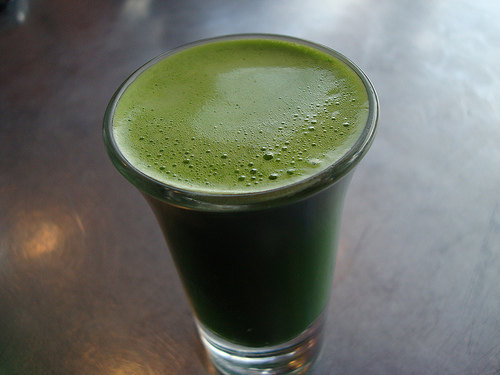

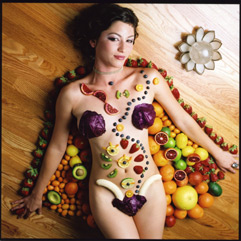
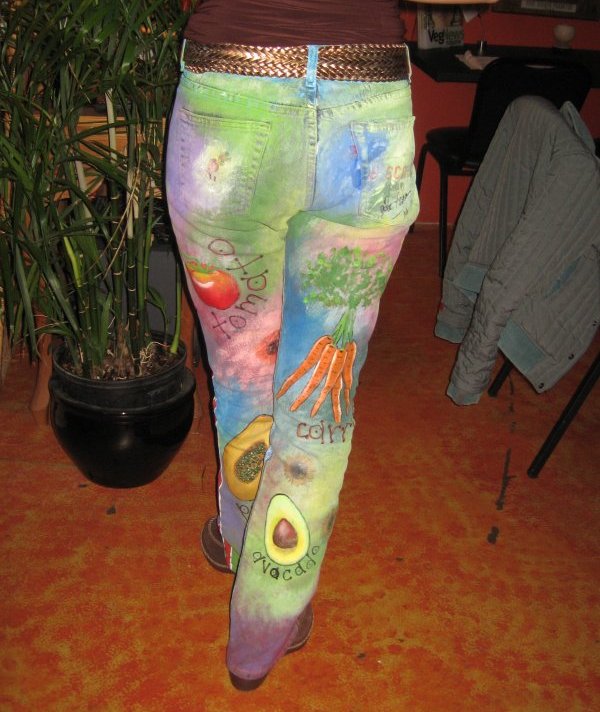




Wholesale to the Public
Your Wholesale Raw Foods & Equipment Connection
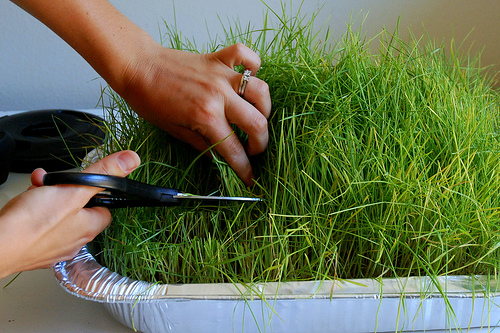
Juicing tips.
The more torque or pressing power the juicer has, the more intercellular juice that can be extracted. Many juicers just extract the free water, which is in the tubules, veins of the produce. The phytonutrients are always in the intercellular water.
Wheatgrass Tips:
Try to juice only the tips where the root auxins are. Never get juice from the 2nd cutting. This is when the wheatgrass goes from vegetative to reproductive stages...this is when the ovul goes up the stem. Many juice bars do this and I do not like this. The 2nd cutting juice, usually on the 12th day, has very little nutrition. You are only cheating yourself if you try to get more juice on that second cutting.
JUICING TIPS:
1. To get more juice, reduce clogging, and simplify cleanup, add some peeled Zucchini squash along with your carrots. My "Carrotini" juice tastes better than it sounds.
2. If there is a "head" of frothy foam on the top of your glassful of juice, you can either enjoy the taste and texture of it (I do) or avoid it by drinking through a straw.
3. If the leftover vegetable pulp produced from your juicer seems damp or even wet, you may be pushing vegetables through too fast. Take your time and let the machine do its job. Use only a subtle pressure, with the plunger supplied by the manufacturer, to send the produce through your juicer.
4. If your family runs for cover at first sight of your intent to liquefy everything in the fridge, then snag your dog. Our dog's ears perk up at the sound of a juicer revving up, for she knows that the cast off vegetable pulp is all for her. We thoroughly mix it with her dog food to greatly increase its vegetable, vitamin, and fiber content. It is also low-calorie, and filling, so it keeps her thin.
No dog? Then put the pulp in your compost pile. No compost pile? Well, why not? Okay, okay, one more option: carrot pulp is just the ticket for carrot cake. And that might just get your family back into the kitchen again.
5. To get more juice out of the same quantity of vegetables, try putting them through your juicer more slowly. A gentle pressure works best; let the machine do the work. Taking your time juicing can yield as much as a third more juice. And, it will also reduce the heat from pressing vegetables too hard against the juicer's blade assembly (I also freeze my blades before I use them to prevent "too" much foaming when doing greens). Reduced friction means cooler juice, which most experienced juicers consider to be better for you. Cooler juice also tastes better.
To this end, I frost up a couple of large drinking glasses, and the glass pitcher I collect the juice in, by sticking them in the freezer each night. Next morning, I begin. Naturally, refrigerating (but NOT freezing!) your fresh produce also keeps everything cooler.
HINT: A good way to check your juicing technique is to feel the discarded pulp. If it is wet, you are losing juice. If it is dry and puffy, you are extracting most of the liquid very well.
6. ANOTHER HINT: Clean the clogs as you go. Carrots and other veggies can be very fibrous at certain times of the year. This is all the more reason to slow the juicing process down a tad. But if you are really going at it, stop juicing every five pounds or so, unplug the juicer, and (carefully) rinse off the blade assembly under running cold tap water.
7. It is wise to peel vegetables that have been sprayed or waxed, such as cucumbers. Sprayed fruits are also good to peel before juicing. Carrots and other underground vegetables often do not need peeling. Instead, give them a good scrubbing with a nylon-bristle vegetable brush while rinsing under tap water. Beets are the exception. Since beet skins are very bitter, it is wise to peel beets before juicing. A hint to save time: dip the beets for about 20 seconds in boiling water and then peel them... it's much easier.
8. It is generally a good idea to dilute your juice 50/50 with water. If you can afford filtered water, use it. If not, don't worry... the goodness of the juices will carry you. Some people, including me, do not like the taste of diluted juice. An alternative is to drink a glass of water, then drink a glass of juice. This gives the same effect, and tastes better. Be sure to drink the water first, for after the juice you may not want the water as much.
9. AND ANOTHER HINT: ( THE BIGGEST HINT OF ALL): For those that don't have much time to spend in the kitchen make sure you get a cheap little anti-oxidation pump to pump out the air bubbles in the juice. This allows to store it in your refrigerator for about 5 days so it won't lose its enzymes and nutrients.
Your juice will taste the best if you drink it right after preparing it. I mean within moments! Fresh juice contains a great amount of raw food enzymes and vitamins, many of which are easily lost as the juice sits (unless you pump the air out with the hand held pump).
When we say "juice", we generally are referring to vegetable juice, freshly prepared. Fruit juice tends to be too sweet for comfortable fasting. However, there is nothing to stop you from experimenting and coming up with your own best regimen. As long as you get good results, HOW you get them is secondary.
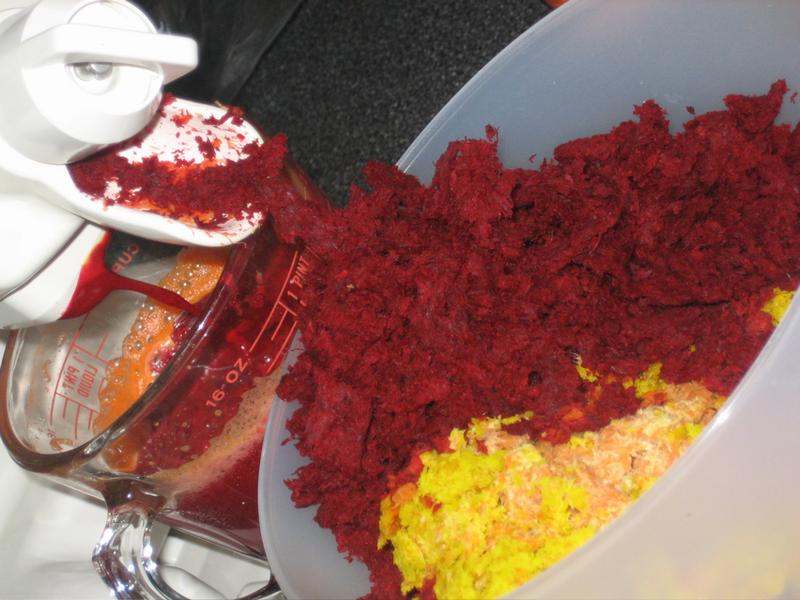
OUR BIGGEST JUICING TIPS
1 Juicing Time: Know how long it takes to juice before you buy. If it takes too much time you probably want use it.
2 Overheating: It sucks when you are in the middle of juicing a gallon of juice and it over heats and you gotta wait 30 minutes for cooldown.
3 Oxidation: Wanna store your juice? You might want to know how much air bubbles the juicer produces
4 Cleaning: Cleaning also sucks. If you can't just throw it in the dish washer, or you don't have time to clean.... Some take only 1 minute to rinse off and others you need to scrub and get your toothpick out and pick those screans.
How long it will last before serious degradation of nutrients occurs?
It's well known that heat and the tiny air bubbles of oxygen rapidly accelerate aging of juice and its nutrients.
It's also well known that the method of juice extraction greatly affects juice quality. If you do not press the juice and take the air out it must be consumed almost iimmediately after juicing to avoid serious oxidative damage; this can be noticed by the brownish color in the juice.
ORP: Juice from a juicer should have an ORP from -100 through +160, indicating a fairly good store of primitive (reducing) antioxidants in the juice (the pH will usually be about 5.6 to 5.9, indicating presence of plant acids). Raw organic carrot juice will sometimes show an ORP as low as -170 to -200 (and a pH of about 6.8 or higher, since carrrots are not as acid as some other vegetables), as will some raw organic wheatgrass juice.
However, most green juices and vegetable juice mixes show an ORP between -100 and +160. As a juice ages and gradually oxidizes(e.g., due to any of these factors: heat, exposure to air and light, time), the ORP will climb steadily, finally reaching a "settling" zone of perhaps +350 to +450. As a juice oxidizes, it steadily loses nutrient value. In general, one would wish to see raw organic green juices in storage remain at or below an ORP of +180, altough one could safely say that an ORP of up to perhaps 210 might be acceptable under some circumstances.
A better way of stating the matter might be this: you do not want to see the ORP rise (toward +1,200) more than 80 counts over the initial value. For those that are intuitive, you can estimate the ORP measure by observations from smell, taste, and appearance.
High speed juicers do not destroy the nutrients any faster than a twin gear juicer...it's what happens after you juice where the problem is. First... some vitamins are not destroyed by heat or air... they are destroyed by light.. Some are destroyed by air and not so much from air... They just tell you it oxidizes the nutrition without knowing what they are talking about. The truth about oxidation of nutrients is very clear if you know physics. Oxidation is a factor of 3 things: Time, Temperature, and Heat.. You have to have all 3 to oxidize. Try putting an apple in the oven. It does not turn brown the instant you put it in. Yes.. the magnates are supposed to make the juice last longer.. up to 48 hours... The magnets produce a focused magnetic field of 2600 Gauss through which the juice flows. If your are going to get a twin gear juicer... get one that crushes or extracts the juice. This is a physical change, not chemical. There's no strippingof electrons and there's no adding of electrons (which magnetism does).
If you need help picking out a juicer, know the following:
Are you juicing greens, roots, veggies, fruits or all of those?
If you want to do all of those, which order is your priority: Fruits, greens, veggies.
Do you care if the juice is warm or cool when done juicing. Warmer juice is more oxidized.
How long do you want to store your juice (let us know from 1 to 7 days)
About how much are you going to juice at a time (cups, gallons)
How long do you want to spend juicing a gallon (10 min, 30 min, 1 hour)
As always, we like to share the argument against juicing. It is up to you do make your own decision.
These opinions may not be the opinions of this website or operators.
Juice is not a whole food. It does not have the nutrient package intact as nature intended.
Juicing is bad for blood sugar levels since the sugars are absorbed more quickly than through normal digestion.
If you juice a lot every day you can develop problems.
Why do we see juice bars popping up everywhere. Can someone say SUGARvore?
If you think you are going to get the best results and proper nutrition from a juicer then read this page!"
It's a shame people think that juice diet from will actually cure them when actually all they are doing is taking out the nutrition and throwing it in the garbage."
"A Juicing diet is for people whose ecology is compromised by moderate to serious digestive strength"
I hope what I am about to say doesn't cause anyone to not want to juice carrots anymore :)
The high glycemic index is not the only problem and the fact that they are hybridized and cannot
reproduce themselves. Root vegetables are known as ‘soil cleansers’ which means that they take up
the contaminants in the soil. That's why there are high amounts of pesticides and other contaminants in
potatoes, carrots, turnips, etc -- and other root crops.�?
GRASS JUICE FACTOR: Grass juice is the ultimate growth factor.
There is an unknown quality that I believe has to do with "root oxins" that cause the aerobic bacteria in our body to grow really fast.
Grass juice is very cheap & easy to grow. I don't buy green vegetables (except for celery or cucumbers). I have no appetite for expensive salads. My needs are completely covered by the grass I grow (or buy when I am away). Grass juice is so chloryphillated and protein rich and so full of enzymes that there is no need for me to buy greens. Juicing grass has been the one of the main factor in producing my aerobic metabolism.
I have seen people who drink grass daily get "magnetically" attracted to foods that have a higher Brixxe value and a higher mineral content. Foods you might not like can suddenly become more attractive when you have an aerobic ecology.
Eating healthier does NOT need to be taught. This is why we do NOT sell books on the raw food diet. Eating should become precognitive and intuitive. We do have a one page handout that pretty much tells you everything you need to do. What we do can fit on one single page. There is no need for a book to teach this. We have seen almost everyone fail when trying to change to a healthier diet.
Many vegetarians are drinking fruit & carrot juices....then... they eat all of the grains and legumes and nuts and seeds.
SO, WHAT ARE THEY CREATING?
They are creating a big fermentation, similar to a beer brewery. Most vegetarians have a very acidic metabolism and a very bad Aerobic ecology. Most vegetarians that I know have the most health problems. They don't have the severity of problems as carnivores or the starchy eaters. If you have concerns about improving your ecology by grassing you might want to look into getting a medal grass juicer. The one we use is the Workhorse 2. I personally think the twin gear juicers are a waste of money and time and a waste of produce. The workhorse 2 has the most pressing power
of any wheatgrass juicer we have found. It puts more pounds per square inch than any other juicer releasing the most stage 2 juice.
Wheatgrass is not good from an electric sprouter...especially wheatgrass with a low Brixxe level.
Wheatgrass in a sprouter... is a sunless food.
The best grasses are the immature primitive greens that you would never buy in a health food store or a juice bar.
I grow my grass for maximum nutrient density.
The more enzymes and minerals the more pungent the taste.
The closer you grow to the jointing stage the better!
I prefer mine bitter and down and dirty!!
The only way to get the benefit from wheatgrass juice is to use a metal juicer. There is no substitute for an all medal auger.
The antioxidants and phytochemicals which are only in the cell walls that need enormous pressure that a plastic juicer cannot give.
Many people go to juice bars and need a shot of wheatgrass. That is the wrong reason to drink it.
Wheatgrass juice is nauseously sweet to someone on the S.A.D. diet. If you are going to juice wheatgrass you will only get stage 1 juice from a plastic juicer. The plastic augers wear out unlike medal gears. A medal juicer gives you the pressing effect and medal does not form pressure pockets either. Most of the chlorophyll and aminos are on the tips of the grass.
If you want to grow your own wheatgrass we recommend the Sundance Vertical Garden (we ship these out through the manufacture twice a month). The more horsepower the wheatgrass juicer has the more pressing power and the more Stage 2 juice you will get.
Stage 2 juice is where all the antioxidants and essential phytochemicals are. The lower your digestive potential the more juice you will have to drink. If you have digestive problems there are certain precautions you might want to take before drinking any type of juice, especially highly concentrated wheatgrass. A junkavore can drink wheatgrass and get nothing out of it but a headache, nausea, mucus in the stomach, and might even throw it up.
BEWARE:
I have seen juice bars that grow their wheatgrass. Make sure you are not getting the 2nd cutting.
When the wheatgrass goes from vegetative to reproductive stages...this is when the ovul goes up the stem.
Wheatgrass on its 2nd cutting, usually cut on its 12 day, has a fraction of the nutrients.
Once you get your first cutting...throw the bedding away and start a new batch. By trying to get as much juice as you can you are only cheating yourself.
Note: Wheatgrass should taste like chlorophyll.
Most juice that I have seen in juice bars taste sweet. It should not taste sweet. It should taste like chlorophyll...not sugary. Wheatgrass that is less sweet has more minerals...not a bunch of simple sugars. If grown properly the grass converts the sugar into minerals. The soil needs to be rich in good bacteria. This bacteria transports the minerals into the feeding roots.
Most people will not like the taste of mineral rich wheatgrass until their ecology is more alkaline and aerobic.
When animals feel sick, they nibble on grass which is instinctive. the desire to chew grass is a natural desire.
Animals know that grass has healing properties. The laws of nature apply to animals as well as us. (Take a dog that is sick to a park and it will naturally take you to the grass).
Please do not get the impression that we are against juicing. We just want to let people know that it is not the "Magic Cure" that it is advertised to be. We want you to understand the facts about juicing and want you to be sure a juicer is what you need.
We have been juicing for many years and have experienced and tested probably every juicer their is on the market and only sell the best in its class. We do not like the way that juicers are being marketed. You do not get the phytochemicals and antioxidants that help certain objectives in juice unless its juiced in a certain way... and I DO not mean by drinking it directly out of a juicer... That's the worst way to drink it... fresh out of a juicer. That is a waste of time and food. The juice that you don't get from a juicer is stage 2 juice which is all in the pulp which is usually thrown down the drain. You do NOT have to eat the pulp or even blend it to get Stage 2 juice. We aren't saying blending is the only way to get the phytochemicals.
As a symbiotic rawfoodist, I take the extra step to obtain the phytochemicals and antioxidants out of the juice. 20 years ago people did the same thing I did but used a Champion juicer. We all know now that juice does not store long from a high speed juicer. I use the Green power juicer to help make my juice and I use the homogenizing screen to make the juice pulpy before it turns into juice. Your juice will only be balanced if you use the homogenizing blank and then extract stage 2 juice from it. Don't worry about Stage 1, that will come on its on. You can even use a 50 dollar juicer at Walmart as long as you drink it right away or pump it immediately after pressing the juice out to take out the air. Remember...and apple doesn't turn brown the minute it touches air. Juice doesn't oxidize either like the manufacturers tell you.
Nutrient loss is a matter of air, temperature and time.
Some nutrients are destroyed by light while oxygen has no effect on it. Some are destroyed by light.
I am tired of the scams they tell you to get you to buy a more expensive juicer.
If you drink fresh juice from a juicer for one month from the homogenizing screen and then the next month go back to standard juicing you will notice the difference. I get that pulpy juice and press it into pulp free juice that now has stage 2 juice that usually is wasted even from this high powered juicer. I get the energy from the tubule juice and the nutrients from Stage 2 juice. I will take more than the split second that a juicer
touches the food to turn it into juice. It's sad people think they are getting nutrition from a high powered juicer that turns the produce into nutrient rich juice instantly. It just doesn't happen as the manufacturers would like you to believe. I wouldn't even drink juice out of the Twin Health juicer as a matter of fact. I am not the only one that does this. Just about every health institute does what I do. It's not a secret unless you have been mislead.
It is well known that cancer is fed by sugar.
It scares us that dealers trying to promote a healthy lifestyle are encouraging a tremendous amount of carrot juicing. We will never tell anyone to drink a lot of sugary foods. Most people that buy a juicer, juice beets, carrots and apples as the staple of their diet. Rarely people will juice green juice unless they know the benefits of it ( there are far more minerals, vitamins and other life-giving plant chemicals in a glass of green juice), and even then, they throw out all the valuable pulp down the drain. "Juicing" fruits and vegetables can actually accelerate cancer and the aging process if drinking it right out of the juicer. The juicer is excellent if you want more vitamins, minerals, and enzymes. But, this does not prevent the body from getting older. When you use a juicer, you DO NOT get the anti-aging nutrients, phytochemicals and fiber(pulp) at all. Phytochemicals are not vitamins or minerals and have nothing to do with the enzymes. They are NON-NUTRITIVE substances found in plants that actually contain protective, disease-preventing compounds.
"Juices are not as balanced as Nature would have it."
(from Rebuild Your Health, Ann Wigmore Foundation, NM, 1991)
OK.. so why do we sell juicers if we don't recommend them. We don't recommend them for healing purposes if you are using the juicer alone.
There is nothing wrong with a tall glass of cool watermelon or organic pineapple juice after a long day or after a tiring workout. Celery juice is perfect when you need it. But just don't think you can get away with juicing to heal cancer or a certain disease by just putting veggies in a juicer and think it will heal you. It's also a waste of money to juice. You have to spend about 5 times as much money to get the same nutrition as you would get out of using a 3HP blender. I drink juice all the time but I certainly don't drink it right out of a juicer and I don't blend it either.
If you have a digestive problem or specific concern that makes it hard to drink the whole blended foods we recommend only buying a juicer if you plan on using it for 3 months or less...or just enough time to transition to blending. Juicers (not wheatgrass juicers) should be a temporary transitional appliance. Juicing should not be a lifestyle. This is what causes many people to get sick...and its a waste of money since most people
throw the pulp in the garbage and its stage 2 juice. Once your body is strong enough to handle whole foods we can help you sell your used juicer to the next customer that wants to do the same transition that you just did. Once you are able to start blending we will buy your juicer back towards credit for a blender. If your situation requires it, we recommend buying a juicer and a blender at the same time as long as you know you can get rid of it when ever you decide. You will not be stuck with the juicer if you buy it from us. Depending on your situation we can help you decide if you need a juicer, blender, or both. We recommend that most people start blending and never buy a juicer but only for certain situations we recommend buying a juicer first. If you are just coming off the S.A.D. diet blending is recommended from the start. Juicing is very concentrated and your body absorbs the nutrition almost instantly. This can be very dangerous if you don't know what you are doing. You need to balance the juices and not do what most people do which is juicing a whole bag of carrots and apples. That is the worst thing you can do. And, juicing greens is an ever worse idea. Only juice if your body can just barely handle any digestion of the whole fruit or vegetable.
One of the most popular juices is raw red cabbage juice. There is a reason why cabbage causes gas...and it's a good thing that it does. Just like when you wash your hands it produces foam. When you drink cabbage juice it creates gas in your colon and that is what happens when you are cleansing yourself... just like washing your hands. The gas is created when the juice is combining with the toxins. Cabbage juice does NOT cause gas in a healthy colon.
The question now comes... should you juice or blend?
The answer depends on how far along you are in your raw food journey. If you have never juiced or blended and you have a condition you need to heal (because you are toxic and unbalanced from a lifetime of junk and cooked foods) your digestive system may not be able to handle the pulp.
We would then recommend getting a juicer and drink the juice until your body is able to handle the blended foods. Just save the pulp and use it in a dehydrator to make raw and yummy phytochemicals/anti-oxidant treats if you are trying to transition.
If you don't have health objectives and just want a lot of energy, then the juicer may be a good choice, but blending and getting a daily dose of fresh phytochemicals will help ensure that you get the benefits of the pulp. Side note about energy...don't get in the habit of juicing sweet fruits all the time like carrots and apples, this is a big problem that people develop. Too much sugar will cause more problems than if you didn't have the juicer. Who can eat 5 lbs of carrots in a day. Some people juice 5lbs of carrots to the point that their skin is orange and they think they are the healthiest people in the world.
When most rawfooders reach 95% raw, we tend to juice less and blend more. Blending is much quicker of course!
(None of our good friends who are 100% raw use a juicer. We all blend). You might not like the taste of it when you are toxic, but when you are mostly raw you can really appreciate and enjoy the taste of a raw living smoothie.
Juice is more palatable, we agree, but if you have the right recipes, then blending will be the better choice. And, for those that have weak digestions and say that they cannot handle the fiber, this is not true of the pulp that has been blended in a 3hp blender. (Also, we have found that if you depend on juice and don't use your digestive system to "digest" foods which is what a digestive system is for... then you will have more problems. It's sort of like exercises). Blended foods in a 3hp blender actually helps those with the excuse that they can't eat a lot of fiber.
Dr. Ann Wigmore - the naturopathic doctor who popularized wheatgrass juice, wrote in her later years, "I no longer advocate juicing, except for wheatgrass and watermelon juice. Blending helps the body to clean itself and thus it restores health much quicker than just eating the foods as salads, yet it does not overtax the system with the rapid cleansing action of juices." Speaking of Wheatgrass, USE caution when using it! Be very cautious, if you have blood pressure problems. Stay far away from it, if you have low blood pressure. And as a matter of fact, if you do the right research, you won't want to drink wheatgrass juice all together. We have consulted many books and resources on this and they all agree that there other greens that can accomplish what you are looking in wheatgrass and have better digestibility. Phytochemicals are the stimulants to an immune system that can fight disease and slow down the aging process. Phytochemicals are in the fiber. Different plants have different phytochemicals. Some help balance blood sugar..some have anti-aging properties-and some help accelerate healing..
Many people want to naturally balance their blood sugar by throwing in Swiss chard or bitter Mellon which has an insulin-like substance in the
cell walls within the fiber. But, they will get better results if it's blended than juiced.
The sugar rush:
Juicing makes it easier than ever before to consume an excessive amount of fast-release carbohydrates.
The body converts high-GI sugars and starchy foods into sugars quickly. They enter the bloodstream very rapidly,
producing a "sugar rush" The normal (non-diabetic) body responds by overproducing insulin to break down or digest
the excess sugar molecules as quickly as possible. This overcompensation reduces the blood sugar blow the optimum level,
resulting in the "letdown" feeling called hypoglycemia. This, in turn, produces a craving for more carbohydrates--nature's
attempt to redress the imbalance. The result of these pendulum swings is a continuing cycle that stresses the body, causes
obesity and mood swings that make effective dieting extremely difficult. With a diabetic condition, the body cannot manufacture enough insulin to "take care" of excess blood sugar, and the consequences are catastrophic.
It can take up to an hour and a half to get a gallon of juice..(You can get a gallon of carrot juice or celery juice much quicker but it's the greens that the most time and most people give up after a few times juicing). Even if it took you 5 minutes to juice a whole gallon- your body only can absorb about 2 cups worth of nutrition at one time.
Your body cannot absorb more nutrients than it needs. Blending takes about 50 seconds and you don't have to do anything but put the fruit and veggies in the container and just turn the switch on.. Fresh smoothies don't store more than 4 hours unless you pump the air out. You can get this pump for about $40 dollars.
It's very popular among rawfoodists who want their juice to last 5 days. The pump is sort of like a reverse bicycle pump. Many people juice the night before so they don't have to do it in the morning. They have no idea that the nutrients are oxidizing by the time they drink it. Get that pump if you ever plan on drinking a smoothie or juice after 4 hours.
Juice is not a whole food. Juice is PROCESSED to the point to where most of the nutritional value is gone. It is not natural for a body to absorb concentrated doses of sugar, such as in carrot or apple juice. Juice might help in the short run due to the nutrients and might make you feel good due to the overdoses of sugar but you will see in the long run that you will want to blend your food. See if the juicer works for you. Maybe you will experience the sugar highs, the cleaning experiences, and the high cost of produce that you waste in the pulp. If you are going to buy a juicer just don't be misinformed. If you already have a juicer we will take it as a trade-in towards a blender if we have a use for it.
Juicers take too much time to set up, operate, and clean. Your time is wasted chopping everything just so it can fit into the chute of your juicer. Juicers are expensive to begin with and drive up your power bill because of the typically long run time. The most expensive twin gear juicers fail to extract a minimum of 25% stage 2 juice and worse yet the 25% contains an average of 40% of the nutrients. Whether you are considering anything from a grossly inefficient centrifugal to a super duper twin gear nothing comes close to the grinding and pressing extraction action of a true stage 2 juicer.
How long it will last before serious degradation of nutrients occurs?
It's well known that heat and the tiny air bubbles of oxygen rapidly accelerate aging of juice and its nutrients.
It's also well known that the method of juice extraction greatly affects juice quality. If you do not press the juice and take the air out it must be consumed almost iimmediately after juicing to avoid serious oxidative damage; this can be noticed by the brownish color in the juice. Recently, a large number of raw foodists have been adding hydrogen boosters to the juice before storage to decrease oxidation and to add storage lifetime to the juice. Oxidation is measured by an ORP meter (oxygen reduction potential). ORP measures the degree of oxidation or reduction (reduction is absence of oxidation and is tantamount to anti-oxidant power) of a water-based substance, and the ORP scale ranges from -1,200 (strongly reducing) to +1200 (strongly oxidizing.)
ORP: Juice from a juicer should have an ORP from -100 through +160, indicating a fairly good store of primitive (reducing) antioxidants in the juice (the pH will usually be about 5.6 to 5.9, indicating presence of plant acids). Raw organic carrot juice will sometimes show an ORP as low as -170 to -200 (and a pH of about 6.8 or higher, since carrrots are not as acid as some other vegetables), as will some raw organic wheatgrass juice.
However, most green juices and vegetable juice mixes show an ORP between -100 and +160. As a juice ages and gradually oxidizes (e.g., due to any of these factors: heat, exposure to air and light, time), the ORP will climb steadily, finally reaching a "settling" zone of perhaps +350 to +450. As a juice oxidizes, it steadily loses nutrient value. In general, one would wish to see raw organic green juices in storage remain at or below an ORP of +180, altough one could safely say that an ORP of up to perhaps 210 might be acceptable under some circumstances.
A better way of stating the matter might be this: you do not want to see the ORP rise (toward +1,200) more than 80 counts over the initial value. For those that are intuitive, you can estimate the ORP measure by observations from smell, taste, and appearance.
High speed juicers do not destroy the nutrients any faster than a twin gear juicer...it's what happens after you juice where the problem is. First... some vitamins are not destroyed by heat or air... they are destroyed by light.. Some are destroyed by air and not so much from air... They just tell you it oxidizes the nutrition without knowing what they are talking about. The truth about oxidation of nutrients is very clear if you know physics. Oxidation is a factor of 3 things: Time, Temperature, and Heat.. You have to have all 3 to oxidize. Try putting an apple in the oven. It does not turn brown the instant you put it in. Yes.. the magnates are supposed to make the juice last longer.. up to 48 hours... The magnets produce a focused magnetic field of 2600 Gauss through which the juice flows. If your are going to get a twin gear juicer... get one that crushes or extracts the juice. This is a physical change, not chemical. There's no stripping of electrons and there's no adding of electrons (which magnetism does).
Just like having a sugar addiction, a cooked food addiction, or any other type of addiction to the Standard American Diet...you can just as easily get addicted to the concentrated sugars that you get from a juicer. It is not natural to drink juice and not eat the entire structure of the fruit or vegetable. The fibers, which contain the anticking and anti-disease qualities in the antioxidants and phytochemicals, are locked in the cell walls of the fibers. These are the building blocks for the foods and not the juice. The true value of the fruit and vegetable is when you eat it in its whole form. Juicers are hard to clean and is the least efficient way to eat. It is a very wasteful lifestyle. Also, most people that juice do not chew their juice. Juicing makes it easy for you to drink and making it very indigestible.
Normally when we eat foods we chew them and we release enzymes to help the food digest. When most people juice they drink it much faster than they would ever eat it. I see people at juice bars drink their wheatgrass shot in one gulp. That is the worst thing you can do for your body. The energy they get is more of a stimulant and burdens the body. If you are just beginning to start the raw food diet...I would hope you believe the wheatgrass hype.
I see juicers all the time at garage sales. I often ask why they are getting rid of it and the answers from everyone always seem to be the same about their experience with the juicer. Most of the time the juicers look like they were barely used and haven't been used in years. I have never seen a 3HP blender at a garage sale.
Juicers have a very big profit markeup for stores. I have called plenty of stores that sell juicers to tell the truth about juicers or at least find out the persons needs who want the juicer before they try to sell them a juicer. I think stores will not stop selling juicers and all the books will continue to promote them. There is just too much profit for them to stop. When I first started selling juicers I was selling more than any store on the net.. Now, that I have had experience with 3hp and 3HP+ blenders I have called almost every customer that bought a juicer from me and offered them to trade in their juicer towards credit towards a 3HP+. Almost all of the customers who didn't know about 3HP blending (mainly since 3HP blending is new technology and we didn't sell them then) have bought a 3HP or 3HP+ blender and either donated or sold their juicer.
I will not knowingly sell a juicer to someone that doesn't need one....just like a doctor will not prescribe medication that he or she feels will not help their patient. If you want a juicer for other reasons, such as for making raw cookie dough or bread, or raw ice cream, please let us know. You can do this much more efficiently in a 3HP blender but the only time people really ever buy a juicer is when they want to make it when others are sleeping and do not want to run a blender. The newer 3+hp blenders are much quieter than the older 3HP blenders that came out a few years ago. Hopefully, juicers will be obsolete in the very near future. In my opinion, its the biggest scam ever invented targeted towards people that are sick and those that want to maintain good health and prevent diseases. With all that being said, if you REALLY want a juicer there is no need to pay over 300 dollars for a juicer. You can get a good twin gear juicer for under 300 dollars. The new compact 14 lb twin gear juicer is now made and is affordable. It doesn't come with all the Fancy pasta maker attachment and books so you are just paying for the juicer and not all the fillers that make a juicer go up in price.
Raw chlorella is the easiest way to get chlorophyll. I eat raw chlorella 3 times a day. Grass juice is another way to get this. These green food signals are unevolved. This is my base food. Wheatgrass juice is another way to get the green food signal. E3 Live is another good one but it is very expensive.
We do offer our cost on E3 live to our co op members which is about 50% off. Once my body has been cleaned, I only need 2 oz of grass juice a day. I started out with 4 to 6 oz in the beginning before I cultivated 3 to 5 lbs of aerobic flora. Wheatgrass juice and other forms of chlorophyll act as detergents. We are not designed to live on detergents. These are for cleansing purposes only. After cultivating this bacteria, lettuce or spinach just tastes like alkaline water. The purer I become the more I enjoy the primitive greens. I do not expect everyone to enjoy drinking wheatgrass juice when their body is toxic.
Juicing vs Blending: To read more see our Blenders page
There is an assumption that juicing makes nutrients more assimilable, but there are several factors to consider.
1. amount of food value released by juicing may be higher due to the method
except that there are clearly many nutrients in the pulp - it is not just non-nutritive fiber.
2. assimilation is impacted by the state of the ingested food. the higher rate of speed that something passes through a "porous tube", the LESS is absorbed. it may be that juicing allows for Less assimilation, or it may be equal to blending, or it may be more. this is not a foregone conclusion. but i would think that it would pass through faster, hence potentially be absorbed less. nobody really knows, and i have not found any studies.
3. when in fact there is no nutrient loss in juicing,there are always nutrients in the pulp, unless you pass it through several times,
or you have the best juicer on the planet
Juicing makes nutrients directly assimilable in the blood...bypassing digestion and allowing the body to rest comparative to eating.
But there is one big problem with juicing, the body is loaded at one single time with nutrients and the organs are not prepared to receive that huge load.
A natural meal is never swallowed at once, the body takes time to chew the food, to digest and to move it slowly thru the digestive system.
The organs, the liver and others are notified and prepare to receive the nutrients at a natural pace.
Juicing is not the optimal meal.
Juicing isn't natural but it can be a good thing how vegetable juice surprises the body in a way. Food should flow through the system in its most natural way, yet juicing serves a unique purpose for those who cannot tolerate blended foods but for most people this is not a problem.
No juicer is complete without this tool. If you are going to juice and want stage 2 juice then this will do the job. It takes 1 minute to clean it.
Gerson therapy has proven that the "grind and press" technique give the best juice and the least amount of waste. The best juicer to use with a press is a "Grinder" juicer. A twin gear homogenizing juicer would be 2nd best but who wants to wait a long time for juice?
Or, you can buy the commercial grade twin gear juicer below for a few thousand dollars and you won't need the press.
Fresh Carrot juice from...
Immediately from a twin gear juicer :GREAT
Immediately from a masticating juicer without homogenizing :Poor
Immediately from a centrifugal :Poor
Immediately from a grind and press (Grinder homogenizer and a press) :GREAT
1 day after storage : :Good
1 day after storage from Anti-Air pump. :Great
1 day after storage w/ micro-hydrogen :GREAT
1 day after storage w/ micro-hydrogen and Anti-Air pump :GREAT
Pasteurized carrot juice from a store, not from a juicer :Poor
Although the grind and press technique is 2nd best when compared to 3+HP blending, a juicer is a terrible attempt to break the phytochemicals out of the cell walls. Most of the pulp gets thrown away anyway. This is where the phytochemicals are. We even go to juice bars and they give us their pulp at the end of the day. We even eat the stems from the pineapple. See About Us if you want to know what they are used for.
The harmful effects of juicing does not come instantly. It takes years of juicing before the problems manifest from drinking juice, especially stage 1 juice. (I have no problems with buying a juicer for transitional purposes). It usually takes 6 months to 3 years before I see people have symptoms ffrom the excessive concentrations of fruit and vegetable juices. After about 6 months I see the sugarvore addiction kick in with almost everyone. (Yes, I do call people back after about 6 months whom I choose to see if they stored their juicer in their garage or they developed a sugar addiction. My customers either want to sell their juicer back to me or they juice every day. It is rarely in the middle).
The cell walls get intoxicated from daily carbohydrate overdoses and usually the body can't absorb it as fast as one can drink it. I've learned that juice
can make the pancreas over secrete insulin and age itself prematurely. After this happens, the blood sugar is burned up too rapidly and this is why juice gives so much energy followed by a big crash, or lack of energy. Juicing is a vicious cycle!
The only exception to juicing is if my digestion was so weak and I my villi was so clogged that I couldn't drink a small smoothie and I had to juice to get tripple or more of the dose of vitamins and minerals that I normally would be able to get just by blending a small quantity since I normally would be absorbing all of it.
It's sad that people use juicing as a lifestyle and they never clean their villi out and never have the beneficial bacteria. Over time, it costs a lot more money to buy the excessive amounts of vegatables and fruits when all it takes is to clean the villi.
If I were going to buy a juicer, I would NOT buy the single auger juicer since it doesn't give stage 2 like the dual augers.
A final note on juicing:
And God Said, "Behold, I have given you every herb bearing seed, which is upon the face of all the Earth, and every tree, in which is a tree
yielding seed; to you it shall be for meat." Genesis Verse 1:29
Take the Juicing Questionnaire to help decide which juicer is best for you.
1. I am juicing mainly to juice:
Greens only
Greens, veggies, and little fruit
Fruits and hard root vegetables
Anything that can be juiced
2. If buying a juicer that is multi-purpose, my priorities are in this order
Fruits, greens, veggies
Fruits, veggies, greens
Veggies, greens, fruits
Veggies, fruits, greens
Greens, veggies, fruits
Greens, fruits, veggies
3. I want juice that is
Cool although it takes longer to juice but the enzymes aren't destroyed
Slightly warmer or even hot
I want to spend less time in the kitchen and I will pump the air out of it if I am storing the juice
Call me and tell me the advantages and disadvantages of both.
4. I plan on juicing about
Once a day
Several times a day
Maybe twice a week or less
For about 3 months and I want to return it or trade it in for a blender when I no longer need the juicer
5. Since I may not want to juice every day, I want juice that will be able to be stored for at least
1 to 2 days
3 to 4 days
5 to 7 days (Pumping the air out in a canning jar is mandatory if you want your juice to last this long without oxidizing)
I plan on drinking the juice immediately
6. Although overheating may occur the longer I juice, I plan on juicing for
under 30 minutes to avoid overheating
30 minutes to 1 hour
Over 1 hour and I will probably need a built in cooling fan so that I don't have to wait 10-15 minutes each half hour or so the motor will cool off
7. How much time do you plan on juicing daily?
under 30 minutes a day
30 min. to 1 hour
over one hour
not sure
8. From my research, the best way to get the most nutritious juice is to use a
centrifugal juicer then sqeezing through a nut milk bag
masticating juicer then straining
grinding juicer then adding the pulp back in
grind and press to take the pulp out
blend it in a 3+HP blender and then squeeze the juice through a nut milk bag
9. The best way to get stage 2 juice is to
blend and then strain through a nut milk bag
pressing and grinding
low RPM auger juicer (single or dual gear)
none of the above
10. The best way to utilize the pulp from your juicer that you don't eat is to
put it into your dehyrator
thermophillic composting
feed to animals
put all of it back into the juice, why not just eat it?
11. What is the main reason juicing is so attractive in the beginning to our customers?
sugar addiction
water addiction
nutrient bioavailability
immediate health benefits
long term health benefits
12. Which juice is optimum for a symbiotic rawfoodist?
non sweet citrus juice
green vegetable juice
sweet ripe fruits
mono wild fruits and any non-cultivar
13. Which is probably the healthiest combonation for general well being?
cucumber & celery
apple and green leafy
carrot and beet
fresh sqeezed orange juice
whatever tastes best
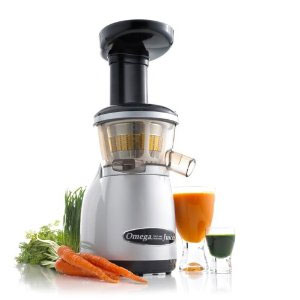
Omega Vert 350 Juicer
SALE ITEM OF THE MONTH.
We cannot advertise our price due to map price rules.
Contact us if you are interested in this juicer.